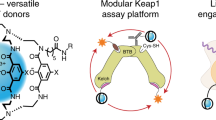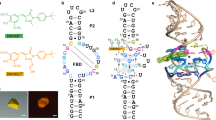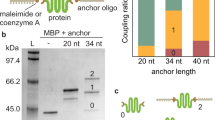Abstract
Fluorescence resonance energy transfer (FRET)-based detection of protein interactions is limited by the very narrow range of FRET-permitting distances. We show two different strategies for the rational design of weak helper interactions that co-recruit donor and acceptor fluorophores for a more robust detection of bimolecular FRET: (i) in silico design of electrostatically driven encounter complexes and (ii) fusion of tunable domain-peptide interaction modules based on WW or SH3 domains. We tested each strategy for optimization of FRET between (m)Citrine and mCherry, which do not natively interact. Both approaches yielded comparable and large increases in FRET efficiencies with little or no background. Helper-interaction modules can be fused to any pair of fluorescent proteins and could, we found, enhance FRET between mTFP1 and mCherry as well as between mTurquoise2 and mCitrine. We applied enhanced helper-interaction FRET (hiFRET) probes to study the binding between full-length H-Ras and Raf1 as well as the drug-induced interaction between Raf1 and B-Raf.
This is a preview of subscription content, access via your institution
Access options
Subscribe to this journal
Receive 12 print issues and online access
$259.00 per year
only $21.58 per issue
Buy this article
- Purchase on Springer Link
- Instant access to full article PDF
Prices may be subject to local taxes which are calculated during checkout




Similar content being viewed by others
References
Miyawaki, A. Development of probes for cellular functions using fluorescent proteins and fluorescence resonance energy transfer. Annu. Rev. Biochem. 80, 357–373 (2011).
Shaner, N.C., Steinbach, P.A. & Tsien, R.Y. A guide to choosing fluorescent proteins. Nat. Methods 2, 905–909 (2005).
Piston, D.W. & Kremers, G.-J. Fluorescent protein FRET: the good, the bad and the ugly. Trends Biochem. Sci. 32, 407–414 (2007).
Lam, A.J. et al. Improving FRET dynamic range with bright green and red fluorescent proteins. Nat. Methods 9, 1005–1012 (2012).
Zacharias, D.A. Partitioning of lipid-modified monomeric GFPs into membrane microdomains of live cells. Science 296, 913–916 (2002).
Landgraf, D., Okumus, B., Chien, P., Baker, T.A. & Paulsson, J. Segregation of molecules at cell division reveals native protein localization. Nat. Methods 9, 480–482 (2012).
Nguyen, A.W. & Daugherty, P.S. Evolutionary optimization of fluorescent proteins for intracellular FRET. Nat. Biotechnol. 23, 355–360 (2005).
Vinkenborg, J.L., Evers, T.H., Reulen, S.W.A., Meijer, E.W. & Merkx, M. Enhanced sensitivity of FRET-based protease sensors by redesign of the GFP dimerization interface. ChemBioChem 8, 1119–1121 (2007).
Ohashi, T., Galiacy, S.D., Briscoe, G. & Erickson, H.P. An experimental study of GFP-based FRET, with application to intrinsically unstructured proteins. Protein Sci. 16, 1429–1438 (2007).
Vinkenborg, J.L. et al. Genetically encoded FRET sensors to monitor intracellular Zn2+ homeostasis. Nat. Methods 6, 737–740 (2009).
Kotera, I., Iwasaki, T., Imamura, H., Noji, H. & Nagai, T. Reversible dimerization of Aequorea victoria fluorescent proteins increases the dynamic range of FRET-based indicators. ACS Chem. Biol. 5, 215–222 (2010).
Golynskiy, M.V., Koay, M.S., Vinkenborg, J.L. & Merkx, M. Engineering protein switches: sensors, regulators, and spare parts for biology and biotechnology. ChemBioChem 12, 353–361 (2011).
Evers, T.H., Appelhof, M.A.M., de Graaf-Heuvelmans, P.T.H.M., Meijer, E.W. & Merkx, M. Ratiometric detection of Zn(II) using chelating fluorescent protein chimeras. J. Mol. Biol. 374, 411–425 (2007).
Walther, K.A., Papke, B., Sinn, M., Michel, K. & Kinkhabwala, A. Precise measurement of protein interacting fractions with fluorescence lifetime imaging microscopy. Mol. Biosyst. 7, 322–336 (2011).
Griesbeck, O., Baird, G.S., Campbell, R.E., Zacharias, D.A. & Tsien, R.Y. Reducing the environmental sensitivity of yellow fluorescent protein. mechanism and applications. J. Biol. Chem. 276, 29188–29194 (2001).
Shaner, N.C. et al. Improved monomeric red, orange and yellow fluorescent proteins derived from Discosoma sp. red fluorescent protein. Nat. Biotechnol. 22, 1567–1572 (2004).
Bayle, J.H. et al. Rapamycin analogs with differential binding specificity permit orthogonal control of protein activity. Chem. Biol. 13, 99–107 (2006).
Grünberg, R., Ferrar, T.S., van der Sloot, A.M., Constante, M. & Serrano, L. Building blocks for protein interaction devices. Nucleic Acids Res. 38, 2645–2662 (2010).
Pires, J.R. et al. Solution structures of the YAP65 WW domain and the variant L30 K in complex with the peptides GTPPPPYTVG, N-(n-octyl)-GPPPY and PLPPY and the application of peptide libraries reveal a minimal binding epitope. J. Mol. Biol. 314, 1147–1156 (2001).
Zarrinpar, A., Park, S.-H. & Lim, W.A. Optimization of specificity in a cellular protein interaction network by negative selection. Nature 426, 676–680 (2003).
Tonikian, R. et al. Bayesian modeling of the yeast SH3 domain interactome predicts spatiotemporal dynamics of endocytosis proteins. PLoS Biol. 7, e1000218 (2009).
van der Meer, B.W. Kappa-squared: from nuisance to new sense. J. Biotechnol. 82, 181–196 (2002).
Lee, K.C. et al. Application of the stretched exponential function to fluorescence lifetime imaging. Biophys. J. 81, 1265–1274 (2001).
Ai, H.-w., Henderson, J.N., Remington, S.J. & Campbell, R.E. Directed evolution of a monomeric, bright and photostable version of Clavularia cyan fluorescent protein: structural characterization and applications in fluorescence imaging. Biochem. J. 400, 531–540 (2006).
Luo, K.Q., Yu, V.C., Pu, Y. & Chang, D.C. Application of the fluorescence resonance energy transfer method for studying the dynamics of caspase-3 activation during UV-induced apoptosis in living HeLa cells. Biochem. Biophys. Res. Commun. 283, 1054–1060 (2001).
Goedhart, J. et al. Structure-guided evolution of cyan fluorescent proteins towards a quantum yield of 93%. Nat. Commun. 3, 751 (2012).
Baird, G.S., Zacharias, D.A. & Tsien, R.Y. Circular permutation and receptor insertion within green fluorescent proteins. Proc. Natl. Acad. Sci. USA 96, 11241–11246 (1999).
Kato, Y., Ito, M., Kawai, K., Nagata, K. & Tanokura, M. Determinants of ligand specificity in groups I and IV WW domains as studied by surface plasmon resonance and model building. J. Biol. Chem. 277, 10173–10177 (2002).
Peyker, A., Rocks, O. & Bastiaens, P.I.H. Imaging activation of two Ras isoforms simultaneously in a single cell. ChemBioChem 6, 78–85 (2005).
Hibino, K. et al. Single- and multiple-molecule dynamics of the signaling from H-Ras to cRaf-1 visualized on the plasma membrane of living cells. ChemPhysChem 4, 748–753 (2003).
Heidorn, S.J. et al. Kinase-dead BRAF and oncogenic RAS cooperate to drive tumor progression through CRAF. Cell 140, 209–221 (2010).
Poulikakos, P.I., Zhang, C., Bollag, G., Shokat, K.M. & Rosen, N. RAF inhibitors transactivate RAF dimers and ERK signalling in cells with wild-type BRAF. Nature 464, 427–430 (2010).
Hatzivassiliou, G. et al. RAF inhibitors prime wild-type RAF to activate the MAPK pathway and enhance growth. Nature 464, 431–435 (2010).
Lavoie, H. et al. Inhibitors that stabilize a closed RAF kinase domain conformation induce dimerization. Nat. Chem. Biol. 9, 428–436 (2013).
Grant, D.M. et al. Multiplexed FRET to image multiple signaling events in live cells. Biophys. J. 95, L69–L71 (2008).
Gibson, T.J. Cell regulation: determined to signal discrete cooperation. Trends Biochem. Sci. 34, 471–482 (2009).
Dueber, J.E., Mirsky, E.A. & Lim, W.A. Engineering synthetic signaling proteins with ultrasensitive input/output control. Nat. Biotechnol. 25, 660–662 (2007).
Lorentzen, A., Kinkhabwala, A., Rocks, O., Vartak, N. & Bastiaens, P.I.H. Regulation of Ras localization by acylation enables a mode of intracellular signal propagation. Sci. Signal. 3, ra68 (2010).
Zhang, Y. & Skolnick, J. TM-align: a protein structure alignment algorithm based on the TM-score. Nucleic Acids Res. 33, 2302–2309 (2005).
Grünberg, R., Nilges, M. & Leckner, J. Biskit—a software platform for structural bioinformatics. Bioinformatics 23, 769–770 (2007).
Schymkowitz, J. et al. The FoldX web server: an online force field. Nucleic Acids Res. 33, W382–W388 (2005).
Rocchia, W., Alexov, E. & Honig, B. Extending the applicability of the nonlinear Poisson-Boltzmann equation: multiple dielectric constants and multivalent ions. J. Phys. Chem. B 105, 6507–6514 (2001).
Pettersen, E.F. et al. UCSF Chimera—a visualization system for exploratory research and analysis. J. Comput. Chem. 25, 1605–1612 (2004).
Weiner, S.J. et al. A new force field for molecular mechanical simulation of nucleic acids and proteins. J. Am. Chem. Soc. 106, 765–784 (1984).
Word, J.M., Lovell, S.C., Richardson, J.S. & Richardson, D.C. Asparagine and glutamine: using hydrogen atom contacts in the choice of side-chain amide orientation. J. Mol. Biol. 285, 1735–1747 (1999).
Duan, Y. et al. A point-charge force field for molecular mechanics simulations of proteins based on condensed-phase quantum mechanical calculations. J. Comput. Chem. 24, 1999–2012 (2003).
Li, M.Z. & Elledge, S.J. Harnessing homologous recombination in vitro to generate recombinant DNA via SLIC. Nat. Methods 4, 251–256 (2007).
Gibson, D.G. et al. Enzymatic assembly of DNA molecules up to several hundred kilobases. Nat. Methods 6, 343–345 (2009).
Pace, C.N., Vajdos, F., Fee, L., Grimsley, G. & Gray, T. How to measure and predict the molar absorption coefficient of a protein. Protein Sci. 4, 2411–2423 (1995).
Gasteiger, E. et al. in The Proteomics Protocols Handbook Vol. 112 (ed. Walker, J.M.) Ch. 52, 571–607 (Humana Press, 2005).
Abràmoff, M.D., Magalhães, P.J. & Ram, S.J. Image processing with ImageJ. Biophotonics Int. 11, 36–42 (2004).
Acknowledgements
This work was supported by the Human Frontiers Science Program (LT-fellowship to R.G.) and the European Union (projects EMERGENCE and PROSPECTS, grant agreement number HEALTH-F4-2008-201648, to L.S.) as well as the Spanish Ministry of Education and Science (Juan de la Cierva fellowship to A.M.v.d.S.). We thank M. Therrien for suggesting the B-Raf–Raf1 detection as well as M. Tyers for supporting the project.
Author information
Authors and Affiliations
Contributions
R.G. and L.S. conceived the study. R.G. designed experiments and synthetic genes. F.S., R.G., A.M.v.d.S. and L.S. performed modeling and FoldX calculations. R.G. and T.F. performed in vitro experiments. J.V.B. and V.B.-S. performed cell culture experiments. R.G.-O., A.M., X.S., J.V.B. and V.B.-S. measured and analyzed FLIM. T.Z. and R.G. further analyzed FLIM data. X.S. and V.B.-S. performed caspase experiments. R.G., L.S., J.V.B., and T.Z. wrote the paper.
Corresponding authors
Ethics declarations
Competing interests
Methods described in this study are subject to two patent applications (PCT/EP2012/075737 and PCT/EP2012/075743) filed by some of the authors (R.G., L.S. and F.S).
Supplementary information
Supplementary Text and Figures
Supplementary Figures 1–18, Supplementary Tables 1–6 and Supplementary Notes 1–4 (PDF 3706 kb)
Supplementary Data 1
Annotated sequences of synthetic proteins and sensors constructs (GenBank format) (ZIP 75 kb)
Supplementary Data 2
In vitro FRET efficiencies (complete data set of FRET measurements on purified proteins) (XLS 45 kb)
Supplementary Software
Python scripts for selection of mutations and cell trace plotting (ZIP 5 kb)
Rights and permissions
About this article
Cite this article
Grünberg, R., Burnier, J., Ferrar, T. et al. Engineering of weak helper interactions for high-efficiency FRET probes. Nat Methods 10, 1021–1027 (2013). https://doi.org/10.1038/nmeth.2625
Received:
Accepted:
Published:
Issue Date:
DOI: https://doi.org/10.1038/nmeth.2625
This article is cited by
-
A general method for the development of multicolor biosensors with large dynamic ranges
Nature Chemical Biology (2023)
-
A moonlighting role for enzymes of glycolysis in the co-localization of mitochondria and chloroplasts
Nature Communications (2020)
-
Genetically encoded fluorescent indicators for imaging intracellular potassium ion concentration
Communications Biology (2019)
-
Fluorometric visualization of mucin 1 glycans on cell surfaces based on rolling-mediated cascade amplification and CdTe quantum dots
Microchimica Acta (2019)
-
Optimizing fluorescent protein trios for 3-Way FRET imaging of protein interactions in living cells
Scientific Reports (2015)



